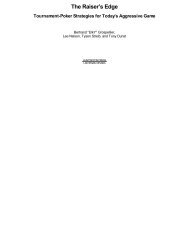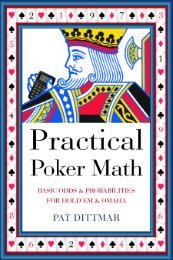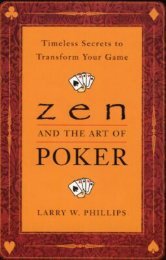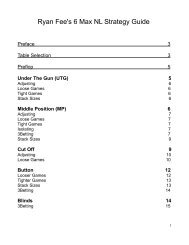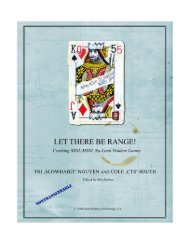You also want an ePaper? Increase the reach of your titles
YUMPU automatically turns print PDFs into web optimized ePapers that Google loves.
136<br />
It's obviously a mistake for him to call, and we profit. However,<br />
he only makes that mistake 14% of the time. When he calls,<br />
we'll own 66% of a $40 pot. He folds 86% of the time, and we<br />
win the $10 pot. Here's our EV when we shove.<br />
0.14(0.66($40)) + 0.86($10) = EV<br />
0.14($26.40) + $8.60 = EV<br />
$3.70 + $8.60 = $12.30<br />
When we bet $5, notice he can call profitably with his big draws.<br />
0.34($15) + 0.66(-$5) = EV<br />
$5.10 - $3.30 = $1.80<br />
So, we allow him to make $1.80 when he calls with his OESFD.<br />
However, he's making a mistake calling with his QJ.<br />
0.11($15) + 0.89(-$5) = EV<br />
$1.65 - $4.45 = (-$2.80)<br />
The QJ hand makes up a significant portion of his range. So<br />
much so, that our EV when we bet $5 is greater than when we<br />
shove. Our total equity against his whole range is 85%. We'll<br />
win a $20 pot 85% of the time.<br />
0.85($20) = $17<br />
So, even though we allow the villain to draw profitably with a<br />
portion of his range, we do better by having the larger portion<br />
make a mistake. Obviously this example is simplified as we<br />
have ignored river betting and position, but the lesson is clear.<br />
Keep the makeup of the villain's range in mind when you're<br />
betting.





